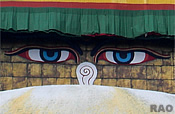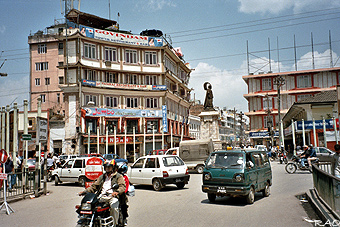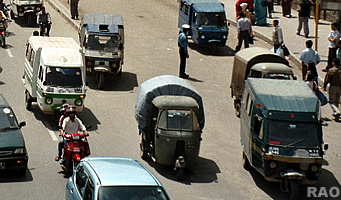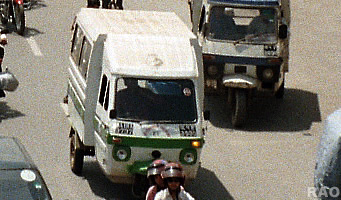 |
Nepal Ennvironment |
 |
Nepal Information |
|
|
 |
|
Nepal
Electro Bus Project for Clean Air
|

|
The
quality of the air in Kathmandu is one of the worst worldwide. Measures
to reduce air pollution are a must. Among others, air pollution is causing
serious, documented health problems, and tourism has decreased, causing
a loss of foreign currency reserves.
 |
|
Tourism
|
 |
The
quality of the air in Kathmandu is one of the worst worldwide. Measures
to reduce air pollution are a must. Among others, air pollution is causing
serious, documented health problems, and tourism has decreased, causing
a loss of foreign currency reserves.
A
recent survey of approximately 2,000 tourists leaving Nepal clearly showed
that tourists felt that the largest issue needing improvement in Kathmandu
was the heavy vehicular pollution. |
|
Sadly,
as a sign of this truth, entrepreneurs have recently been able to make
profits selling pure oxygen in bars for tourist and local Nepali consumption
in this once pristine country.
One
measure to improve the situation is the introduction of new types of Electric
Vehicles (EV's), which should replace old polluting vehicles. The inputs
of SDC aim at supporting the activities of the Himalayan Light Foundation
(HLF) and at assisting in reaching sustainable solutions.
Kathmandu
is probably the city with worldwide the highest number of EV's operating
in public transportation. 650 "Safa Tempos" (3-wheel electric passenger
vehicles) are in use, employing over 1000 Nepalese every day.
They
play an important role in Kathmandu's transportation system. About 100'000
passengers directly profit daily from this clean form of transportation.
The Safa Tempos have proved to be the viable and approved substitute when
the heavily polluting Diesel Vikram tempos were banned in 1999.
According
to a USAID study, the 1500 or so polluting predecessors of the "clean"
three wheeled tempo, called "Vikram" Tempos spewed dense clouds of unregulated
black smoke into the air and were responsible for more than 25% of the
on-road vehicular traffic and upwards of 30% of the valley's pollution.
As
a result of that original electric vehicle project, there are now more
than 600 electric three-wheeled Clean Tempos plying the streets of Kathmandu
as part of the city's public transportation system.
Based
on the private sector's success in sustainably setting these clean vehicles
in motion and in response to the customers requirements for a safer, more
modern Electric Bus, the Himalayan Light Foundation commenced the Electro-Bus
development and demonstration project in 2001 in order to design a few
prototypes of electro- Buses and to test the technological and financial
viability while encouraging the private sector to adapt the Electro-Buses
for local manufacture.
The
HLF Electro-Bus programme took the vehicles through theoretical design
stages, matching these findings with readily available or "off-the-shelf"
electric vehicle components such as controllers, motors, switching devises,
data acquisition units, deep cycle batteries and other local components.
The locally produced prototype Electro-Buses were then tested on fixed
routes to check their technical capabilities and to make adjustments and
improvements
top
|
Advantages
of Electro-Bus for Nepal
|

|
 Presents and alternative to several thousand 20 year old, heavily Presents and alternative to several thousand 20 year old, heavily
polluting
vehicles
 Substantially
reduces overall Kathmandu valley pollution Substantially
reduces overall Kathmandu valley pollution
 Offers
larger seating capacity than SAFA Tempos of 15 - 20 seats Offers
larger seating capacity than SAFA Tempos of 15 - 20 seats
 Presents
no dangers of leaking LP gas Presents
no dangers of leaking LP gas
 Needs
no internal subsidy from Nepal Oil Corporation to be Needs
no internal subsidy from Nepal Oil Corporation to be
commercially
viable |
 Does
not produce uncontainable waste Does
not produce uncontainable waste
 Helps
Nepal revive its crippled tourism industry Helps
Nepal revive its crippled tourism industry
 Presents
passengers with added safety over three wheelers Presents
passengers with added safety over three wheelers
 Uses
Nepal's own clean excess off-peak hydro power and save Nepal Uses
Nepal's own clean excess off-peak hydro power and save Nepal
foreign
currency
 Modern
design will help Kathmandu's overall look Modern
design will help Kathmandu's overall look |
Salient
Features:
 Ranges
between 90-120 Kilometers per charge without battery Ranges
between 90-120 Kilometers per charge without battery
exchange
 Charges
by Off peak hydro power Charges
by Off peak hydro power |
Salient
Features:
 Seats
between 15 - 20 passengers Seats
between 15 - 20 passengers
 Runs
at speeds up to 45 KM/Hr and reaches the higher speeds much faster than
SAFA tempos. Runs
at speeds up to 45 KM/Hr and reaches the higher speeds much faster than
SAFA tempos. |
|
| Source:
Swiss Development Corporation (SDC) 2005 |
 |
top
| more information |
 |
|
Links
|

|
 |
 |
External
link |
|








